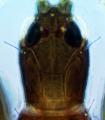Karnyothrips flavipes
Recognition data
Distinguishing features
Female fully winged. Body, legs and antennae mainly brown, tarsi and antennal segment III yellow, tibiae yellowish brown, fore wings pale. Head longer than wide, eyes larger dorsally than ventrally; dorsal surface with little sculpture; postocular setae close to posterior margin of eyes, slender, capitate, wide apart; maxillary stylets retracted to postocular setae, about one third of head width apart. Antennae 8-segmented; sensoria sometimes small and difficult to observe, segment III with 2, IV with 3 or 4. Pronotum with little sculpture; four pairs of slender, capitate major setae, anteromarginals minute; prosternal basantra large, about as long as wide; mesopresternum transverse. Fore tarsus with small curved tooth at inner apex. Metanotum faintly reticulate. Forewing slender, weakly constricted medially, with about three duplicated cilia. Pelta reticulate; tergites II–VII with two pairs of sigmoid setae; tergite VIII setae S1 and S2 slender and capitate; tergite IX setae S1 capitate, S2 very long and acute; anal setae longer than tube.
Related and similar species
About 45 species are listed in the genus Karnyothrips, but it is questionable how many of these should be placed in the same genus. A key to 14 species from Central and South America that have been placed in this genus was given by Mound & Marullo (1996), and a key to 11 species from Japan was given by Okajima (2006), whilst Stannard (1968) included three North American species within his treatment of the genus Haplothrips. The problems in distinguishing between these two genera are discussed by Mound & Minaei (2007). K. flavipes differs from K. longiceps in having setae S1 on the eighth abdominal tergite capitate rather than pointed; both species have capitate S1 setae on the ninth tergite.
Taxonomic data
Current valid name
Karnyothrips flavipes (Jones)
Original name and synonyms
- Anthothrips flavipes Jones, 1912: 18
- Cryptothrips salicis Jones, 1912: 20
- Haplothrips longisetis Bagnall, 1913: 297
- Zygothrips pullus Hood & Williams, 1915: 127
- Cryptothrips citri Watson, 1918: 73
- Zygothrips inermis Hood, 1919: 79
- Trichothrips ripicola Priesner, 1919: 134
- Haplothrips funki Watson, 1920: 23
- Karynia weigeli Watson, 1922: 7
- Haplothrips harnedi Watson, 1922: 45
- Haplothrips oneco Watson, 1924: 58
- Haplothrips cubensis Watson, 1924: 59
- Hindsiana catchingsi Watson, 1924: 80
- Watsoniella jonesiana Cott, 1950: 187
Family placement
Phlaeothripidae, Phlaeothripinae
Biological data
Life history
Apparently predatory on other small arthropods.
Host plants
Collected frequently from many habitats, but primarily from dead branches and also on dead leaves and grasses; less commonly in flowers and on leaves.
Tospoviruses vectored
None
Crop damage
None
Distribution data
Area of origin
Possibly southern USA
Distribution
Widespread around the world in tropics and sub-tropics.







